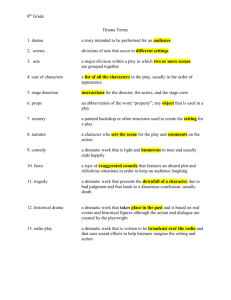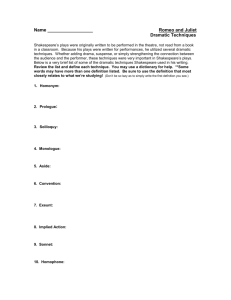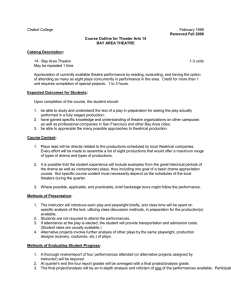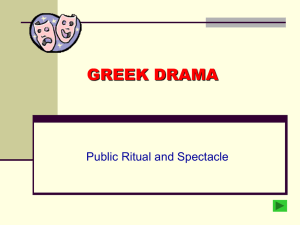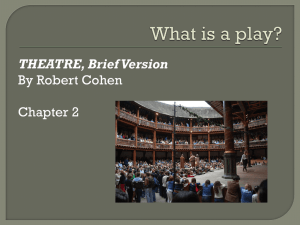CHAPTER 3 THE PLAYSCRIPT Terms
advertisement
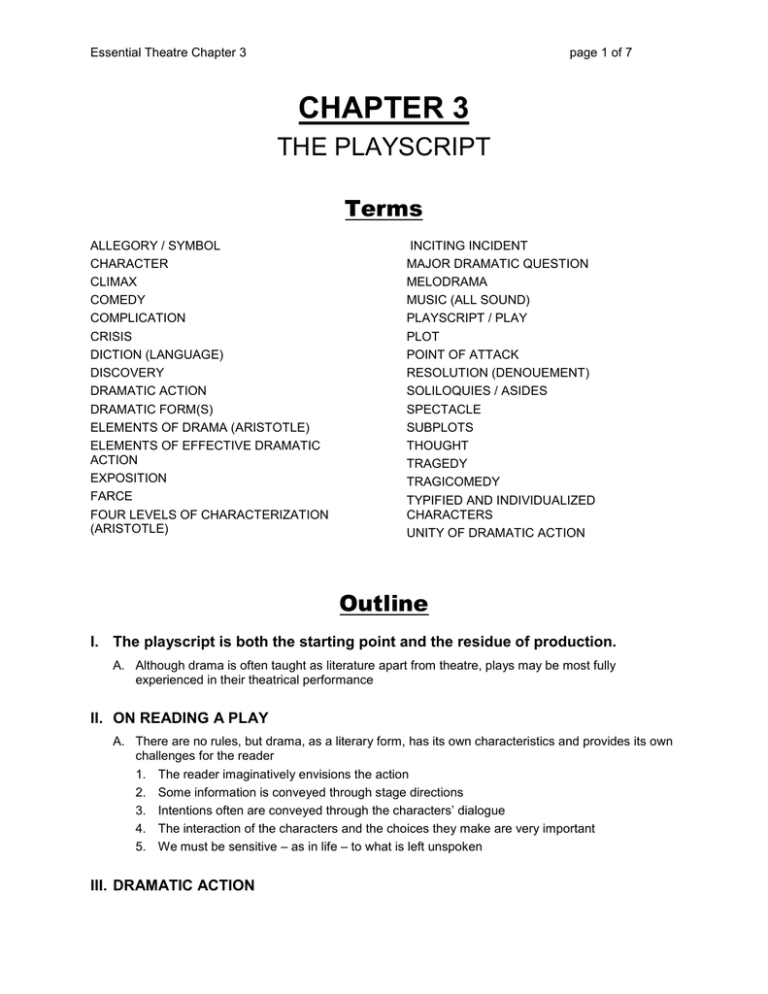
Essential Theatre Chapter 3 page 1 of 7 CHAPTER 3 THE PLAYSCRIPT Terms ALLEGORY / SYMBOL CHARACTER CLIMAX COMEDY COMPLICATION CRISIS DICTION (LANGUAGE) DISCOVERY DRAMATIC ACTION DRAMATIC FORM(S) ELEMENTS OF DRAMA (ARISTOTLE) ELEMENTS OF EFFECTIVE DRAMATIC ACTION EXPOSITION FARCE FOUR LEVELS OF CHARACTERIZATION (ARISTOTLE) INCITING INCIDENT MAJOR DRAMATIC QUESTION MELODRAMA MUSIC (ALL SOUND) PLAYSCRIPT / PLAY PLOT POINT OF ATTACK RESOLUTION (DENOUEMENT) SOLILOQUIES / ASIDES SPECTACLE SUBPLOTS THOUGHT TRAGEDY TRAGICOMEDY TYPIFIED AND INDIVIDUALIZED CHARACTERS UNITY OF DRAMATIC ACTION Outline I. The playscript is both the starting point and the residue of production. A. Although drama is often taught as literature apart from theatre, plays may be most fully experienced in their theatrical performance II. ON READING A PLAY A. There are no rules, but drama, as a literary form, has its own characteristics and provides its own challenges for the reader 1. The reader imaginatively envisions the action 2. Some information is conveyed through stage directions 3. Intentions often are conveyed through the characters’ dialogue 4. The interaction of the characters and the choices they make are very important 5. We must be sensitive – as in life – to what is left unspoken III. DRAMATIC ACTION Essential Theatre Chapter 3 page 2 of 7 A. “Dramatic action” refers to not only what characters do but also to why they do it 1. The actions of the individual characters relate to some question, problem or theme that forms the dramatic action of the play as a whole B. Critic Francis Fergusson suggested that dramatic action builds through a three step process: a. Purpose – awareness of a desire or a goal b. Passion – strength of a desire or passion to fulfill a goal c. Perception – the understanding that eventually comes from the struggle C. All plays share some of the qualities of effective dramatic action. 1. They are complete and self-contained – have a beginning, middle and end 2. They are deliberately shaped or organized to reveal their purpose 3. They have variety 4. They engage and maintain interest 5. They are internally consistent (even if, as is the case in The Bald Soprano, the action is inconsistent, it should be consistently inconsistent) BOX – Aristotle’s Poetics Greek Philosopher, 384-322 B.C. Studied under Plato, served as the tutor of Alexander the Great, and founded the Lyceum school Although a biologist by training, Aristotle wrote influential works in a number of fields including his study of drama, the Poetics - the oldest surviving treatise on drama The Poetics divides drama into two basic types: Tragedy and Comedy; although Aristotle only treats Tragedy at length Scholars are still debating various aspects of this work, wherein Aristotle makes observations concerning which plot arrangements and devices are the most effective, but even those who disagree with Aristotle generally concede the work’s significance as the greatest single influence on ideas about the nature of drama, dramatic structure, and dramatic form IV. METHODS OF ORGANIZING DRAMATIC ACTION A. A play is composed of incidents organized to accomplish a purpose 1. The most common sources of unity are: a. Cause-to-effect arrangement of events i. Attempts to surmount obstacles make up the substance of the play, each scene growing logically out of those that precede it. b. Character i. Primary emphasis on one character, most plays of this type focus on a biographical personage (for example, Abraham Lincoln) c. Thought i. Scenes linked through a central theme or set of ideas. 2. Other sources of unity are: a. Dominant mood b. Visual style c. Distinctive use of language Essential Theatre Chapter 3 page 3 of 7 B. The organization of dramatic action may also be approached through the parts (or elements) of drama, which, according to Aristotle, are: 1.Plot 2.Character 3.Thought 4.Diction 5.Music 6.Spectacle V. PLOT A. Plot is the overall structure and arrangement of a play 1. The Beginning a. Establishes place, occasion, characters, mood, theme and internal logic b. The beginning of the play involves “exposition” c. The amount of exposition is partly determined by the “point of attack” d. Playwrights motivate the giving of exposition in many ways e. Most plays include an “inciting incident” f. The inciting incident leads to a “major dramatic question” i. Not all plays include an inciting incident or major dramatic question, but instead have a central theme 2. The Middle a. Consists of rising action composed of a series of “complications” i. The substance of most complications is “discovery” ii. Each complication has its own beginning, middle and end iii. Other means, such as disasters, can be used to precipitate complications b. The series of complications culminates in the “climax” i. The climax is often accompanied (or preceded by) the “crisis” c. Not all plays have a clear-cut series of complications leading to climax and crisis i. Interest is maintained by introducing new elements in an ongoing pattern of tension and relaxation d. One way of analyzing a play is to divide it into motivational shifts by the characters (typically called “beats” or “units”) 3. The End a. The final portion of a play, the “resolution” or “denouement”, extends from its crisis or climax to its conclusion 4. Plays may also have “subplots” a. Subplots are secondary actions or events that bear a meaningful relationship to the main plot b. Subplots often become a major factor in resolving the main plot VI. CHARACTER AND CHARACTERIZATION A. “Character” is the primary material from which plots are created B. “Characterization” is anything that delineates or differentiates one person from another – it operates on four levels: 1. Biological 2. Sociological 3. Psychological 4. Ethical C. A playwright may emphasize one or more of these levels Essential Theatre Chapter 3 page 4 of 7 D. A character is revealed in several ways: 1. Through stage directions, prefaces or other explanatory material 2. Through what the character says 3. Through what the others in the play say about the character 4. What the character does (chooses) E. Characters are usually both typified and individualized F. Characters may be sympathetic or unsympathetic VII. THOUGHT A. Includes themes, arguments and the overall meaning of the action B. Meaning in drama is usually implied rather than stated directly C. Dramatists in different periods have used various devices to project ideas 1. Greek playwrights used the chorus 2. Later periods used soliloquies, asides and other forms of statement 3. Some plays use allegory and symbol D. Just because plays imply or state meaning, we should not conclude that there is a single correct interpretation for each play. VIII. DICTION A. Language or diction, is the playwright’s primary means of expression, used to: 1. Impart information 2. Characterize 3. Direct attention to important plot elements 4. Reveal themes and ideas 5. Establish tone or mood 6. Establish internal logic 7. Establish tempo and rhythm B. A dramatist always selects, arranges and heightens language. C. The dialogue of nonrealistic plays deviates markedly from everyday speech D. We judge diction’s effectiveness by its appropriateness to character, situation, internal logic and type of play. IX. MUSIC A. Music, as we ordinarily understand the term, does not occur in every play. 1. However the term may be extended to include all patterned sound B. A written script, like a musical score, is not fully realized until the performers transform print into the elements of sound: 1.Pitch 2.Stress 3.Volume 4.Tempo 5.Duration 6.Quality C. The spoken aspect of language varies in its formal qualities D. A play may also use music as: 1. Incidental songs and background music 2. Musical accompaniment as integral structural means - musicals and opera E. Music serves several functions: Essential Theatre Chapter 3 1. 2. 3. 4. 5. 6. page 5 of 7 Establishes mood Characterizes Suggests ideas Compresses characterization and exposition Lends variety Adds pleasure X. SPECTACLE A. Encompasses all visual elements of a production 1. Movement and spatial relations of characters, 2. Lighting, settings, costumes and properties 3. The playwright does not have full control over spectacle 4. Theatre artists strive to discover the play’s intentions and supply the appropriate amount and type of spectacle to convey these intentions 5. The reader of a script must envision the spectacle B. Some scripts give the reader more help than others 1. In many older plays, clues to spectacle must be sought in the dialogue 2. Since the 19th century it became common to include stage directions in plays 3. In evaluating spectacle, we should be most concerned with appropriateness and distinctiveness. XI. FORM IN DRAMA A. Scripts are frequently classified according to their form: 1. Tragedy 2. Comedy 3. Tragicomedy 4. Melodrama 5. Farce, and other forms BOX – Analyzing Scripts Whereas the box on pages 48 offers many different questions to assist students in their attempts to gain a greater understanding of a play, these questions are by no means intended to be exhaustive or prescriptive. B. “Form” means the shape given to something for a particular purpose 1. A play is a form created by arranging incidents in a particular order to create dramatic action. 2. Not all plays have the same form 3. Tragedy and comedy have been considered the two basic forms XII. TRAGEDY A. The oldest known form of drama 1. Presents genuinely serious action and maintains a serious tone 2. May contain moments of comic relief 3. Raises significant issues of human existence, morality or relationships Essential Theatre Chapter 3 page 6 of 7 4. The protagonist arouses our sympathy by encountering disaster while in pursuit of a worthy goal. B. Tragedy is associated especially with ancient Greece and Elizabethan England BOX – The Possibility of Writing Tragedy Today XIII. Some, such as critic Joseph Krutch, believe it is impossible to write tragedy in modern times because our jaded conception of human beings cannot embrace the idealized notion of “nobility” or a “hero.” Playwright Arthur Miller disagrees with Krutch, and argues in his essay, “Tragedy and the Common Man,” that all that is necessary to arouse tragic feeling is a character, “willing to lay down his life, if need be, to secure one thing—his personal sense of dignity.” COMEDY A. Had its origins in ancient Greece. 1. Based on some deviation from normality in action, character or thought 2. Requires the audience to view the situation and events objectively 3. Any subject, trivial or important, can become the subject of comedy if we sufficiently distance ourselves from its serious implications XIV. OTHER FORMS A. Not all plays are wholly serious or comic, but rather mix these aspects 1. For example, Melodrama is a form in which serious action is resolved happily a. Popular form in the 19th century (still dominant in some films and television dramas) b. Depicts a world in which good and evil are sharply differentiated c. Creates a desire to see the “good guys” triumph and the “bad guys” punished B. During the past century, concern for giving formal labels to plays has greatly diminished as playwrights have increasingly mingled various characteristics C. We may divide plays into categories of basic forms without becoming dogmatic or forcing plays to fit rigid conceptions of these categories XV. STYLE IN DRAMA A. One reason for the variance in form is “style” 1. Style results from a distinctive mode of expression or method of presentation a. Style may stem from traits attributable to: i. Period - in most periods, Western drama has certain common qualities caused by prevailing cultural concepts and theatrical conventions ii. Nation - within a period, national differences distinguish a French style from an English style iii. Artistic movement - neoclassicism, romanticism, expressionism, etc. iv. Author - plays of individual authors have distinctive qualities B. Style in theatre results from three basic influences: 1. An assumption about what is truthful and valuable a. The individual playwright’s conception of truth is determined by basic temperament, talent, and by the culture in which he or she lives 2. The manner in which a playwright manipulates the means of expression Essential Theatre Chapter 3 page 7 of 7 a. Individual perceptions of the human condition are reflected in situations, characters, ideas, language, and spectacle 3. The manner in which a play is presented in the theatre a. Production style is characterized by the directing, acting, and various design aspects
